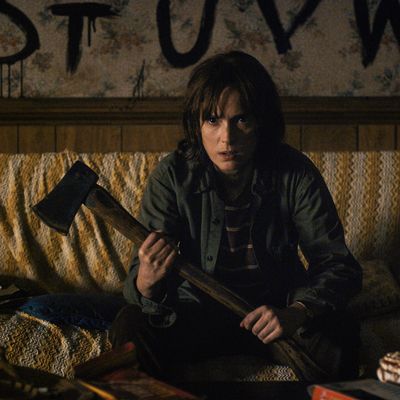
“The Monster” makes a hard shift toward supernatural horror, with two serious jump-scares in the pre-credits sequence alone, so I’m going to make a hard shift toward talking about Stephen King, whose influence on Stranger Things I haven’t mentioned to this point. The shot of Nancy’s outstretched hand puncturing through the portal to the netherworld is a nod to the closing scene in Brian De Palma’s adaptation of King’s Carrie, one of the all-time-great stingers in movie history. And both are premised on reversing the same false assumption: Once you cross over to the Great Beyond, there’s no coming back.
Yet the differences between the two are telling. In Stranger Things, the outstretched hand is a simple misdirection, shocking the viewer into thinking the creature is grabbing at Jonathan when, in fact, it’s Nancy emerging from the portal. In Carrie, it’s a nightmare, fueled by a teenager’s guilt over her role in ostracizing one of her fellow students. One is an effective scare that dissipates; one is an effective scare that lingers. And that, in a nutshell, is the significant flaw in this otherwise entertaining series. There’s nothing in the Duffer brothers’ nostalgia trip that’s uniquely resonant or built to last. It’s a temporary endorphin rush.
Consider the biggest King connection here: Eleven, or Elle, whose telekinetic powers bring her in line with the heroines in King’s Carrie and Firestarter. I haven’t read Firestarter — which, given the girls’ ages, may be the more appropriate comparison — but Carrie is essentially a coming-of-age scenario tweaked into a horror novel, expressing the dramatic swings of adolescent emotion as a violent flurry of psychic activity. Carrie becomes dangerous when she no longer has control of her feelings, and thus, no longer has control over her powers. It’s an extreme version of the growth that confuses and torments all teenagers: Our bodies betray us at the most vulnerable time, and for Carrie, that betrayal is devastatingly complete.
There are flashes of Carrie’s third-act aggression in “The Monster,” which finds a distressed Elle turning her stress and anger on the manager of a grocery store and the bullies who force Mike to jump off a cliff. We’ve seen it before, in the flashback where Elle fatally smashes one handler into a tiled wall and snaps the neck of another like a twig. In the last episode, she knocked Lucas unconscious while trying to break up a fight, which led to a temporary rift between close friends. Elle’s power is always a lingering threat, particularly when she gets upset or feels under attack.
But Elle’s telekinetic abilities aren’t really a metaphor for anything. They’re a storytelling device — an effective one, to be sure — meant to recall the childhood stolen from her. Stranger Things doesn’t register the trauma of that as much as it should, but “The Monster” does explain how she got to this point, far enough to make you marvel that she has a shred of humanity remaining. It turns out that Elle has been property of the Department of Energy since birth, when Dr. Brenner and company swiped her from her mother, then claimed the baby had died in the third trimester. The show has consistently doled out scenes from Elle’s childhood under Brenner’s watch, which has required a push-and-pull between emotional manipulation and ruthless weaponization. She’s been built to fight the Soviets. And she has, improbably, remained an empathetic child, if not a joyful one.
With only two episodes left to wrap things up, “The Monster” ticks along at a much faster clip than the previous hours, as our heroes frantically search for the truth about Will and Barb and the faceless creature, all while our villains work to contain the situation. Joyce and Hopper track down Elle’s birth mother, whose 12 years of unanswered suffering has brought her to a state of catatonia. Having deduced that the creature has shark-like feeding habits, Nancy and Jonathan regroup and resupply for a “monster hunting” expedition with gasoline, bear traps, and boxes of ammunition. Lucas goes off on his own to look for Will while Mike and Dustin search for Elle, who they’d abandoned after she sabotaged their mission for being “unsafe.” Trying to play the unifier, Dustin reminds Mike that the trolls took them out one-by-one when they split up on the “Bloodstone Path,” so it’s best for them to stick together. From the sacred text of D&D, the boys have found a design for living.
Dustin reaches again for a pop-culture metaphor in questioning the futility of taking the fight to the creature without Elle, likening it to “R2-D2 going to fight Darth Vader.” (Though C-3PO would be the cleaner example here, since R2-D2 has a proven track record of getting the job done calmly and efficiently — provided no one tips him over, of course.) But Elle needs to relieve a burden, too. “The gate,” she says. “I opened it. I’m the monster.” It’s a heartbreaking rationale for a girl victimized since birth, right up to the moment when Brenner cajoled her into contacting the creature. She started this. It has to end with her, too.
Demogorgons:
- Corey Hart’s “Sunglasses at Night” is an appropriately stalker/obsessive music cue for Steve as he climbs up to Nancy’s window. I have an affection for that single, but one of Hart’s reasons for wearing sunglasses at night (“So I can so I can/ Keep track of the visions in my eyes”) is a grievous insult to optometry as a profession.
- Stranger Things has a lot of story to tell in eight hours, but it’s a shame the Duffer brothers couldn’t carve out some time to show the making of that slick Indiana A.V. Club pamphlet.
- That’s Amy Seimetz doing great work as Elle’s chain-smoking aunt. Seimetz first caught my attention as the co-lead in Shane Carruth’s Upstream Color, but she’s also a distinguished writer-director — first with her debut feature Sun Don’t Shine, and more recently with the superb Starz series The Girlfriend Experience, which she’s co-writing/directing with Lodge Kerrigan. She’s a triple-threat talent to watch.
- Jonathan’s alley scuffle with Steve is a nod to the hilariously protracted fight between Roddy Piper and Keith David in John Carpenter’s They Live. Too bad so many people are around to break it up.


